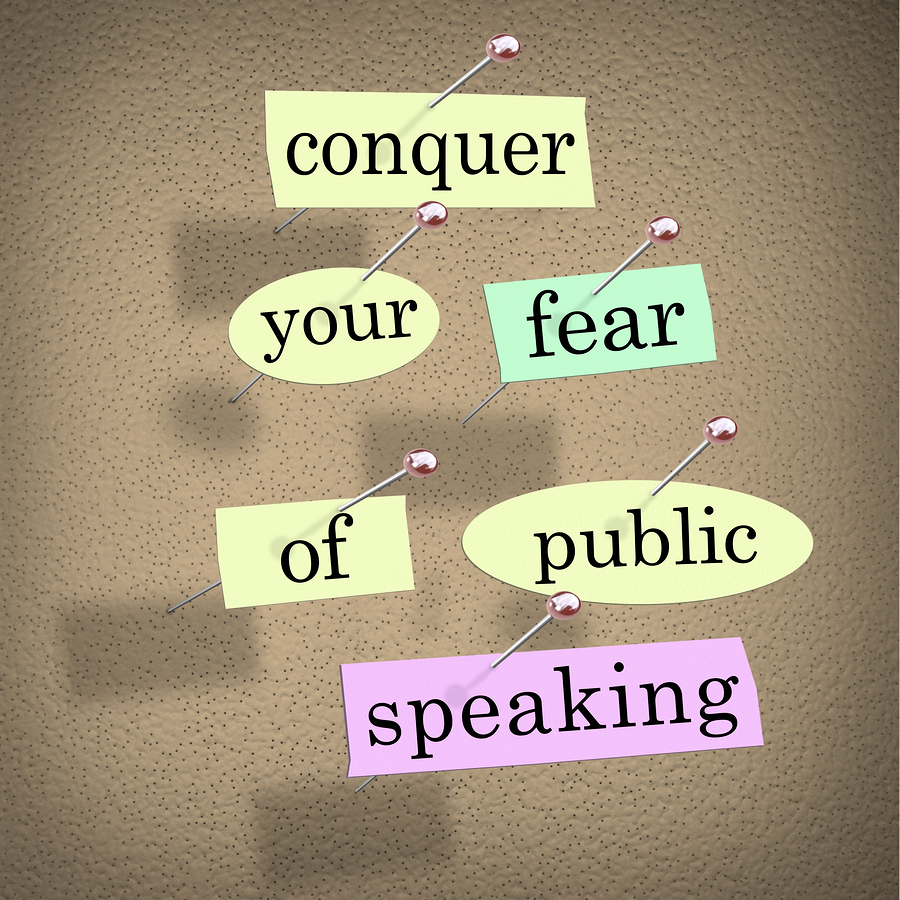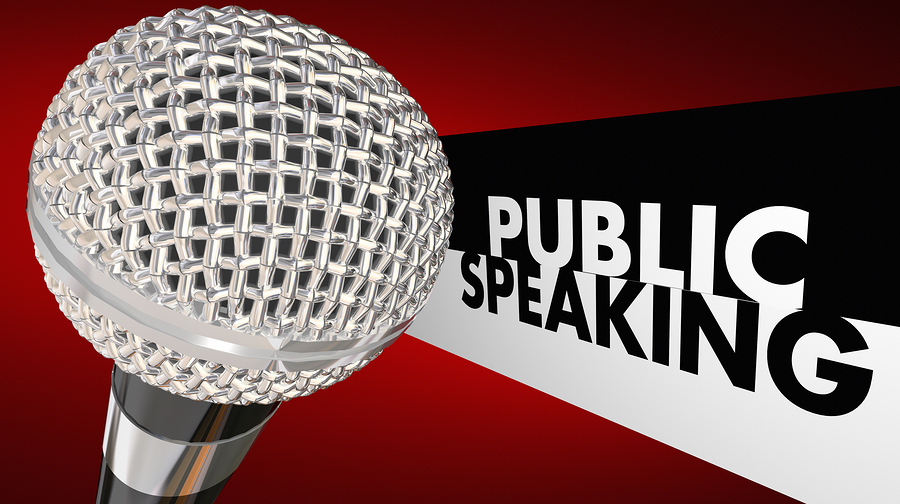They say that the two most significant fears of the average person are death and taxes. But add one more fear to this collection of phobias: the fear of speaking. Even among people who make their living in public performance, there are some who still suffer from a high degree of anxiety as a result of their fear of public speaking.

What are you really afraid of?
In most cases, it’s not the public speaking that scares people. It is the fear of failure. It is the fear of not getting across the things that you want to say in the right way, a fear of offending some in the audience or just stumbling over your words in general. In short, it is a fear of falling on your face.
Well, you can first forget about all of these fears. Because it is going to happen. Sometimes you will offend someone. Occasionally you will stumble over your words. Sometimes your whiteboard will fall, narrowly missing the person on the second row. No matter what you say to a group, someone is bound to be offended. It’s just human nature. This is because, while most people in your audience will agree with your ideas, they will not agree with everything. But remember that getting everyone to agree is not the goal of your speech or presentation.
The goal should be to present your material in a way that appeals to your audience and gives them some “takeaways” to use in their lives or business.
No matter what your topic, you can be a great speaker if you can learn how to cut through the anxiety.
Here are five tips that should help you feel the fear and do it anyway:
1. Be prepared.– The best way to thwart disaster is to be prepared. This includes having your presentation ready, whether written or visual, having all of your materials and tools in proper working order, and knowing what you are going to say. This will cut down significantly on a lot of the anxiety that can be caused by not feeling adequately prepared for your talk or presentation.
Brainstorm well before you put it in digital form. Steve Jobs always said, “Plan in analog.” Take a legal pad or notebook and brainstorm ideas before compiling that PowerPoint or SlideShare presentation. This gives you plenty of time to think of everything you can to make your performance better. You will see your submission changing as you proceed, but that’s a natural part of the process.
2. Listen to other great speakers.– If you want some inspiration, learn from the best. Watch speakers who truly have their act together. Some examples that come to mind are Brian Tracy (on time management), Steve Jobs, and Neil Patel. These are three examples of speakers who knew exactly what they thought about a topic and always presented their material in a compelling way that captured the attention of their audiences. By watching how they handled themselves on a stage, in an interview, or a radio show, you will pick up on tried-and-true techniques that are sure to lessen your degree of anxiety.
Be yourself, but learn from the best. It will give you an added confidence boost when you prepare and present your material to an audience, whether online or in person.
3. Focus on the message.– It’s important to remember that a movie is a movie, but the actor is the thing. In other words, when you clear away all of the bells and whistles of a presentation and technology such as PowerPoints, digital media, and special effects or servers, all you have is your message. As a test, think about what you would say to your audience if you lived in a time before all of the tools and high-tech and focused on the message you would deliver without all of the extras.
4. Do meditation and visualization exercises before the event.– Many successful entrepreneurs use meditation to clear their minds and learn to become more self-aware. Meditation, contrary to popular belief, alerts the senses rather than dulling them. If you meditate regularly or engage in visualization techniques, you may be able to revert to this calming effect in your mind before you present your next lecture and ease yourself into a relaxing calm. But don’t be too calm! Audiences respond to speakers with a high level of energy, and you’ll want to be awake in case your whiteboard falls on top of your audience.
5. Do it a lot!– The best way to defeat fear and do it anyway is to do it a lot. Over time, you will realize that, even when mistakes happen, you will survive it! The person the whiteboard fell on top of won’t sue you. The people who are offended won’t slander your name all over Facebook (usually). You won’t be psychologically scarred should something happen to your PowerPoint presentation or if you stumble over your words now and then. Just laugh it off and go on.
Applied Psychology in Speaking
Remember that your audience is there because they like your ideas or at least what they have heard about you. They wouldn’t be there if not. Now is your chance to present your case about what you like, believe, or desire. So put your best foot forward and don’t worry about the rest. You’ll get through it, after all!

Some Final Thoughts
So hopefully your whiteboard won’t fall onto one of your audience members causing physical injury that is actionable. Hopefully, you won’t stumble over your words so badly that people think you are speaking in a foreign language. Hopefully, you will be able to communicate exactly what you want to communicate without embarrassing yourself or falling over the podium. But in an imperfect world, anything is possible. So be prepared.
Murphy’s Law, unfortunately, seems to happen most when you least expect it, especially with live performances or presentations. Whether it’s before a live audience or online, prepare for the worst but try to expect the best.
Learn from the shipwrecks of others
I remember attending a live webinar once that featured a “professional” on the topic of building brands and affiliate marketing. But, because he stood there for over 30 minutes speaking with audio only coming through his live feed on Livestream, I can remember nothing other than the laughter and thumbs down icons from the audience.
What a disaster! What happened that caught this guy unaware? I’m not sure. But he said that there was some problem with his server or a technical error of some kind. After this, he came back the next day apologizing for his mechanical issues and trying to proceed with his talk.
But he had lost the credibility with his audience due to his lack of attention to technical details and a general failure to do due diligence to avoid wasting the participants’ time. I decided that the problem was due to his negligence, and not the fault of the Livestream network. People will forgive some minor technical issues but don’t let this happen if you can help it by being prepared and checking your professional equipment.
Remember this disaster when you plan a live webinar and keep telling yourself it can’t be as bad as that! But, with technology, anything can happen.
It’s not Armeggedon
We hope this helps you have less fear when you prepare for your next presentation. Remember the earth doesn’t rise or fall on your presentation. No tidal wave of mass destruction will result for your lack of perfection. The alternative to not speaking is being silent, and this is not something anyone wants in a free society.
We live in a country that allows free expression of ideas in this United States. So enjoy your First Amendment and feel free to share your ideas, as long as they are not threatening to anyone.
Don’t worry about mistakes. Being human is what people want. Think of each performance as an opportunity to take your place on the stage of life and whether they throw roses or tomatoes, it’s all an equal part of your journey through life.
